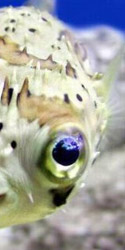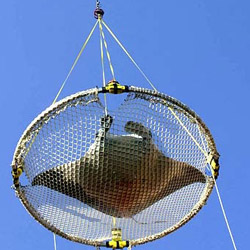|
Home » Articles » Fishless Cycle

 Introduction Introduction
Before we can have a discussion of fishless cycle, we need to make sure everyone understands what we mean by the term “cycle.” The Nitrogen Cycle is the most important thing we need to understand as fishkeepers. It’s chemically a very complicated process, but here’s the Cliff’s Notes version. Fish produce ammonia (urine), the problem is that ammonia is very toxic. Now, in nature, the currents in the water just carry the waste away until it’s processed. In the home aquarium unfortunatly, we don’t have that luxury, what we do have however, is millions of little allies. Those allies are in the form of bacteria, probably of the genus Nitrosomonas, these bacteria take the bad ammonia and convert it to nitrite. Great huh? Not really. Nitrite is just as, if not more toxic than, ammonia, so the process repeats itself, just with a new set of bacteria, probably from the genus Nitrobacter, and the end product is nitrate which is far less toxic. That isn’t the end though, we still need to get rid of that nitrate because it’s still toxic, just not as bad as the others. The only effective way to get rid of nitrate is frequent partial water changes, so don’t neglet your tank maintenance! For a bit more in depth discussion of the Nitrogen cycle, check out this link.
Now, what do we mean by “cycling” a tank? Cycling a tank is simply building up colonies of bacteris that are large enough to handle all the ammonia your fish produce. Now, the nitrifying bacteria are all around us, in the air we breath and the water we drink, all we need to add is a food source (ammonia) to get them to multiply in our filter. There are two ways of going about this. The first is the “traditional” method of putting a few hardy fish in the tank and hoping they survive the stress of the cycle. The second method, the point of this writing, avoids the stress on the fish by artificially adding ammonia.
How do I fishless cycle?
As I mentioned above, to cycle a tank you need to add ammonia. If you do choose to reduce the stress on your fish, and fishless cycle, the first thing you need is a source of ammonia. This one’s pretty easy, just run down to your local grocery store and pick up some clear ammonia. Make sure it’s clear ammonia with no perfumes, surfactants, or other additives; the label should say something like “clear” or “pure” ammonia.
Now that you have your ammonia, the fun begins. Add ammonia until your test kit reads 5ppm (you do have test kits right?). Since different brands off ammonia have different concentrations, there is no formula for “x amount of ammonia per gallon,” you just need to keep testing. Once you’ve added you ammonia, test daily and try to keep the level above 5ppm. The exact amount isn’t really important, just make sure the bacteria have a constant supply of food.
Every few days, test for nitrites. After a few days (or maybe a few weeks) you should see your nitrite level slowly rise, peak and then start to drop off. As the nitrite is dropping, you should start seeing nitrates. Once your nitrite registers “0” your tank is cycled!
Ways to speed up the cycle.
There are a couple of ways to speed up the cycle. The first is simply to raise the temperature of the tank. Chemical reactions are accelerated at higher temperatures, which causes the bacteria to divide faster. Be careful not to raise it too much however, over a certain point, bacterial growth is impeded. I’ve found the mid- to high-eighties work well. Obviously this won’t work in a tank that is already stocked, you don’t want to end up with cooked fish!
The second way to accelerate your cycle is to add “seed” bacteria to your tank. The more bacteria you have, the faster they’ll be able to multiply. There are a few ways to add bacteria, the easiest (and cheapest) way is to take some gravel or filter media from an established disease-free tank and add it to your own. It’s also possible to go down to your LFS and buy some sort of bacteria-in-a-bottle additive (Cycle, Stress-Zyme, etc.). It is the opinion of this author however, that these products are designed to do nothing more than part you from your money.
Why Fishless Cycle?
Perhaps the most common question asked of me when it comes to fishless cycle is, “Why bother? Why should I bother with all those test kits and adding ammonia and all that other stuff, when I can just throw in a few hardy fish and let nature take its course?” Well, as impolite as it may be, I always answer this question with a question. What is a “hardy” fish? Certainly, it’s not a fish that’s immune to ammonia posioning. All fish are hurt by ammonia, it’s just that “hardy” fish are more likely to survive. As fishkeepers however, our goal shouldn’t be that our fish merely survive the stress, our wish should be that our fish thrive . It’s our duty to provide the best environment possible for the creatures under our care. Posioning our fish with toxic chemicals such as ammonia and nitrite is not the best possible environment; especially when it could be avoided through a process as simple as fishless cycle.
Thank you for taking the time to read my rant. If you have any questions, feel free to e-mail me , or better yet, post on the message board.
By Josh Wright
|


 Introduction
Introduction



{ 14 comments… read them below or add one }
Hi, I think that it is also worth mentioning using live rock as a filtration media. Live rock is an immense filtration tool within a salt water aquarium. I also agree 100% percent with your comments on hurting the fish. We keep these aquariums for the life we maintain within them and if this means hurting a fish to set it up then this is wrong – hence my point about live rock.
Also I have to say that is an amazing picture – it looks like an aquatic version of ET!.
Well… the picture wasn’t originally included with the article, but ended up there with a site redesign. I can see where it gives the impression this is a saltwater based article, but it was originally written about fishless cycling in freshwater aquariums.
You’re absolutely right… Cycling a saltwater aquarium is an entirely different animal, and generally allowing live rock to cure in your tank is all you’re gonna need for a cycle.
~JW
Hi i am going to buy a 75 gallon fish tank i read that before u add fish u have to cylce the water a few wks is this right.
Thank you for all your knowledge, I love MFT (and MTS).
My ammonia is dropping but my nitrites are staying high should i keep adding ammonia
Hi,
I’m actually in the middle of the cycle last night i added 1cleaner shrimp a mexican turbo snail and 3 regular cleaning snails but i have a problem i keep getting this long dark green slime that has been hosting in my tank for the past month and a half i clean it out but it grows back consistantly i vaccum it out and brush it out im also thinking about cutting back my light i have one month to go before i add my 2 clowns and maybe some other things but i’m really in a tough situation any suggestions?
Good information here! I have a tank that has been running since mid-July. I chose the fishless cycling method, adding pure ammonia. It took two months for nitrites to show up. Now they have… and I want them to leave! It has been a month now since the nitrites showed up, and i have no signs of nitrates, and no sign of the nitrites going down. I was adding stress-zyme to try to “speed bacterial growth,” but stopped spending the money. One day I got a reading of zero nitrites but I think it was a faulty test for whatever reason, I got the same readings as before the next day, but I had algae growth so I thought it was okay. (I use API’s master kit).I added several more plants and three tiger barbs anyways (like an idiot). They have been in there for a week and a half now, and are doing ok, but showing signs of nitrite poisoning. Nitrites are still high with no nitrates. It’s been over a month. What can I do? Thanks!
I agree completely a animal should never have to go through that
Does it take longer for a brackish tank to cycle than it does a fresh water tank ?
umm i just chuck the fish straight in after it wamrms up and my fish ljive for years i jsut chuck in all kinds of speciece without adding each week
I have to be able to afford ammonia,bacteria,and test kits and more bacteria?!?! I’m not made of money!
i have a question. I recenlty bought 6 barbs after setting up my tank (though not having read your rant about fishless cycling) 4 are dead 2 weeks in. Should i empty the tank once the last 2 die and start over with the fishless cycling process before getting more fish (assuming these last two don’t die. please help.
Great post on cycling a new tank.
Check out my website and read my article on cycling a new tank
http://www.cichlid-fish.com
Let me know what you think!
There is a product called Tetra SafeStart can instant cycle or nearly instant cycle your new fish tank.
http://petskeepersguide.com/fishless-cycle-nitrogen-cycle/